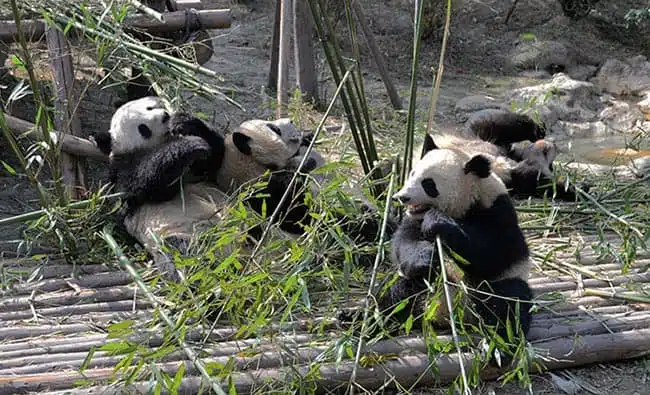Chengdu Research Base of Giant Panda Breeding, located in the northern suburb of Chengdu, is 15 kilometers away from the city center and covers an area about 670,000 square meters, which is an important place for the conservation of giant pandas in China. Chengdu Research Base of Giant Panda Breeding is a world-class non-profit research institute of giant panda breeding to save endangered wild animals. The Base is equipped with scientific research buildings, open research laboratories, veterinary hospital, animal houses, swan lake, the giant panda museum, the panda hospital, the panda kitchen and so on. With the dense bamboo and fragrant flowers, the base integrates charming natural scenery and beautiful artificial landscape, which is suitable for the giant panda and a variety of rare wild animals breeding to live.

Basic Facts about the Chengdu Research Base of Giant Panda Breeding:
- The giant panda is a mammal with alength of 1.2-1.8 meters and a tail length of 10-12 centimeters. It weighs 80-120kg and the heaviest one canup to 180kg. The giant panda is black and white, with round cheeks, two black eyes, a chubby body and sharp claws, which is regarded as one of the loveliest animals in the world. The giant panda is endemic to China. It mainly inhabits in the mountainous areas of Sichuan, Shaanxi and Gansu provinces in China.
- The giant panda has been living on earth for at least 8 million years, whichis honored as “living fossil” and “national treasure of China”. It is the image ambassador of WWF and the flagship species of biodiversity conservation in the world. According to the third national wild panda population survey, there are less than 1,600 giant pandas in the wild, and they belong to the first-class state-protected animals in China. Giant pandas originally ate meat, butnowadays even 99% of them eat bamboo through the evolution. But their teeth and digestive tract remain intact, and they are still classified as carnivores, as dangerous as other bear species. The life span of wild Giant pandas is 18 to 20 years old, while pandas can live more than 30 years in captivity breeding. As of November 2019, the amount of captive giant pandas reached 600 in the worldwide.
- Chengdu Research Base of Giant Panda Breeding simulates the wild ecological environment of giant panda to offer a better environment for animals here. With the green coverage rate of 96%, it has built an ecological environment that is suitable for giant panda and a variety of rare wild animals to live and multiply. There are about 80 giant pandas, red pandas, black-necked cranes, white cranes and other rare animals here all year round.People can not only appreciate the cute panda and other rare animals, but also acquiremany knowledge about them through the tour.

How to Buy Entrance Ticket:
- Price of Entrance Tickets:
| Admission Fee | CNY 55 |
| Sightseeing Bus | CNY 10 |
Note: If the tourists visit Chengdu Research Base of Giant Panda Breeding on foot, it may take about 3 hours. So, if you want save time and energy, you can choose to take sightseeing bus, which just takes about 1.5 hours.
- Opening time:
| Chengdu Research Base of Giant Panda Breeding | 07:30-18:00 |
| Sightseeing Bus | 07:30-18:00(April to October); 08:00-17:30(November to March) |
When is the best time to visit?
As the national treasure of China, pandas are loved by people all over the world, so thousands of tourists come to the panda base every day. Nowadays, it is equipped with advanced tourist facilities and convenient transportation, so it is suitable for visiting all year round. It is wise for you to come in the morning, because the earlier the time, the fewer tourists.
Tips: Visitors had better avoid the official holiday in China, because many Chinese citizens choose to travel on official holidays to ease the pressure of their work. As a result, many Chinese tourist attractions are overcrowded and traffic jams are common. Therefore, visiting China at this time will bring tourists a less pleasant travel experience.
Official Holidays in China
| Chinese New Year | Around January or February |
| Winter vacation | January-February |
| Labor Day | May1st -3rd |
| Summer vacation(for students) | July-August31st |
| Mid-Autumn Festival | Around mid-September |
| National Day | October 1st-7th |

How to tour in the Chengdu Research Base of Giant Panda Breeding?
There are two travel routes that we highly recommended based on different travel hours, and visitors can choose according to their own preferences.
A 1.5 hours tour
Main Entrance→Swan Lake→Sub-adult Panda Enclosure→Adult Giant Panda Enclosure→Giant Panda Cub Enclosure→Sunshine Nursery House for Giant Panda→No.2 Red Panda Playground→Red Panda Nursery House→No. 1 Red Panda Playground→Giant Panda Cinema→ No. 14 Enclosure→Panda Scientific Discovery Center→Giant Panda Museum→Main Entrance
A 3 hours tour
Main Entrance→Swan Lake→Sub-adult Panda Enclosure→Giant Panda Cub Enclosure→ Sunshine Nursery House for Giant Panda→No.2 Enclosure for Giant Panda→Moonlight Nursery House for Giant Panda→No.1 Enclosure for Giant Panda→Giant Panda Kitchen→Panda Hospital→Panda Scientific Discovery Center→Giant Panda Museum→Main Entrance
How to get to the Chengdu Research Base of Giant Panda Breeding?
Bus
- It is convenient for visitors to take Bus No.87, 198, 198a or 655 and get off at Chengdu Research Base of Giant Panda Breeding (Xiongmao Jidi) Station.
- Visitors can also take Bus No.60 or 87 and get off at Longqing Road Shulong Lukou Station, then walk about 15 minutes along the Panda Avenue to get to the base.
Subway
- Visitors can take Subway Line 3 and get off at the Panda Avenue Station, then walk to the base.
Tourist Bus
- There are many tourist buses at other tourist attractions in Chengdu, such as the tourist buses form Wuhou Temple or Jinli to Panda Base, which is about 25KM; and the tourist buses form Kuanzhai Alley or Chunxi Road to Panda Base, which is about 25KM; or from Chengdu Bus/ East Railway Station to Panda Base, which is about 30KM.

Recommended Tours:









